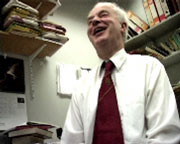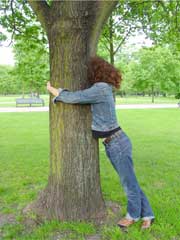Biopresence
A Design Proposal by Georg Tremmel and Shiho Fukuhara
What is Biopresence?
Where did you get the idea from?
Why do you want to make human DNA tree?
How will the resulting trees look?
Is it possible to put human DNA into a tree at all?
Is it possible to replace a tree's junk DNA with human DNA?
Are there other possibilities to store human DNA in a tree's genome?
What are your further steps? When will you make human
DNA trees?
Can I put my DNA into any tree I want?
Will you need to get a licence from the Advisory Commission
on Releases to the Environment (ACRE) if you get this done?
What is your main concern in making these trees?
Media: BBC, Independent, Times, Telegraph, Scotsman,
CBC, Mirror, Hindustan Times, netscape.co.uk. Yahoo India, Science. etc...
^What is Biopresence?
Transplant Biopresence proposes to put the complete DNA information of a human being into the DNA of a tree. By using a special process the genes of the tree will not be altered in any way, therefore creating a tree that will look, grow and behave like any other tree, BUT it would carry the biological information of a human.
^Where did you get the idea from?
We were always interested in the way different cultures deal with the loss of loved-ones, but the inital idea came when we heard about a friend's dog. The dog died, the friend buried him and planted a tree on the grave. Everytime he looks at the tree, he thinks of his dog. We found this symbolic act of passing on life from the dog to the tree very interesting and very touching.
^Why do you want to make human DNA trees?
We were interested in building bridges. A symbolic and poetic connection between Life and Death, amd a more concrete connection between critical art/design and the public perception of biotechnology.
^How will the resulting trees look?
The resulting tree will look like any other tree. We are in the process of researching possibilities to store human DNA information in a tree's genome without affecting the tree and it's characteristics in any way.
^Is it possible to put human DNA into a tree at all?
It is possible, were are currently finding out the best approach to accomplish
this goal.
The initial idea was to replace the tree's junk DNA with human DNA, but
for various reasons we are also trying to find other possibilites.
During a recent meeting with Joe Davis, an research affiliate from MIT
Biology Lab, we had the chance to learn about more simple and more elegant
ways of inserting human DNA into a tree's DNA.

Dr Bernard Lamb from Imperial College's Biology Department after we told him about our idea.
^Is it possible to replace a tree's junk DNA with human DNA?
The initial proposal was based on two facts: The first fact is that the total DNA size (genome) can differ between various organism's. For example, some trees have a larger genome than humans. The second fact is that an organisms genes only occupy a relatively small amount of an organism's genome. In most trees only about 3-5% of the total DNA are typically used to code for the genes (which code for amino acids > proteins >cells). The remaining 95-97% of a tree's DNA, are remainders of evolution, they do not server any obvious function other than serving as a filling material between the genes. These part of the DNA are called junk DNA, or short, jDNA. Transplant Biopresence proposes to replace a tree's jDNA with the complete DNA of a human. Because all of the tree's genes are there, its phenotype (the way he looks) stays intact, its genotype, however, is different. It is human. The process of inserting human DNA will be carried out in the germ line, therefore every single cell of the resulting tree will carry human DNA. There is no reason why the human DNA should not be passed on to further generations. Dr. Bernard Lamb, a reader in Genetics at Imperial College's Biological Sciences Department helped in an independent verification of our proposal. He stated that it is absolutely possible to replace a tree's jDNA and he also confirmed that the resulting tree would probably not differ from any other tree of the same species.

Meeting Joe Davis, Artist and Reseach Affilliate at MIT, in Berlin, May 2003.
^Are there other possibilities to store human DNA in a tree's genome?
Joe Davies, an artist and research affiliate at MIT's Biology Lab in
Boston, proposed recently a way to encode information into an organisms
DNA without affecting the organism itself at all.
By taking advantage of the fact that most base triplets (codon) code for
two or more amino acids, it is possible to create a difference in the
genotype without affecting the phenotype. For example the codons UUU and
UUC code both for the amino acid Phenylanaline, by assigning 0 to UUU
and 1 to UUC it is possible to write either 0 or 1 without changing the
amino acid, because both UUU and UUC produce Phenylanaline.
^What are your further steps? When will you make human DNA trees?
We are currently trying to get funding and facilities in order to realsise this project. If everything works according to plan it should be possible to create a human DNA tree within a year.
^Can I put my DNA into any tree I want?
If the research process is successful it is possible that this service
could become publicly available. There is no reason, why other tree could
not be used.
If you want to put you name on the waiting list please contact: georg.tremmel@rca.ac.uk
^Will you need to get a licence from the Advisory Commission on Releases to the Environment (ACRE) if you get this done?
We are still very early in the process, but if we realise this project
in the UK we will certainly get a licence form the ACRE.
However, we are not sure if the resulting tree qualify as transgenic trees,
because strictly speaking we do not change the genes of the tree in any
way.

^What is your main concern in making these trees?
Whichever way is chosen in the end, it is possible to 'transplant' human DNA into a tree, therefore creating some kind of 'biopresence'.
"We are interested in the moral, ethical and social issues this new
kind of tree will raise. How will a person's approach to a tree change,
if the tree carries human DNA? Will it still be just a tree, or will it
be more?"
One of the main concerns with this project is how the relationship between
human and human DNA trees would change.
Can it be a memorial for a recently deceased person? Or what if you would
put the DNA of an aborted fetus into a tree? What about the preservation
of these human DNA tree? Would it change the city landscape?
Will it also be availabe for my pets?
Implanting your Grandmothers DNA into a tree brings a whole new meaning
to a 'Granny Smith', Georg
Tremmel and Shiho Fukuhara ask, "Would you eat an apple from your
Grandma tree?".
---------------------------------------------------------------------
^Transplant Biopresence is a project
by Georg Tremmel and Shiho Fukuhara at
the M.A. Interaction Design Course at the Royal College of Art in London
Georg can be reached at: georg.tremmel@rca.ac.uk or at 07951 392 346,
Shiho at: shiho.fukuhara@rca.ac.uk or 07939 240 965.
The original press release: HUMAN_DNA_TREES.doc
Georg and Shiho appeared on: Radio BBC 3, Radio BBC 4, R5L, Radio BBC Wales. The interview at BBC LDN's 'Drivetime' on Wednesday, 21st of May: Georg_and_Shiho_on_BBC_LDN.mp3 (thanks to Murat for the recording.)
Transplant Biopresence was featured on page 6 of the Independent on Monday, May 26th: An apple tree bearing human DNA: Arts Students seek the ultimate forbidden fruit.
The Times ran a short article about the project: The art of creating a human tree (note to 'A Correspondent: Shiho's surname is spelled Fukuhara, not Fukahara. Thank you.)
The same day in the Telegraph: Thanks for the memory with your DNA in tree (also not here: its Fukuhara...)
The Scotsman writes: Students to preserve human DNA in trees (Fukuhara...)
The Mirror: THE TREE OF HUMAN LIFE - Our DNA injected in seeds
The Hindustan Times: Growing trees with human DNA
netscape.co.uk: Students to grow tree of life
Yahoo India: Growing trees with human DNA
Wednesday, 28th May. Recording a radio interview with Mary Lou of CBC (Canadian Broadcasting Corporation) 'As it happen'.
The Sunday Times: Woman
offers to be first 'DNA burial' in a tree
Clarifications concerning
the poorly investigated article in the Sunday Times.
Agrifood Awareness Australia: APPLE TREE WITH HUMAN GENES.
Rainet News (Italy): Gran Bretagna, allo studio albero con dna umano
checkbiotech.org: An apple tree bearing human DNA: Arts students seek the ultimate in forbidden fruit
origo.hu (Hungary): Fa keresztezése emberrel
Science: Transgenic Thomstone (unfortunatly this service is subscription based...)
---------------------------------------------------------------------
Transplant Biopresence can be seen at The Show, an exhibition at the Royal College of Art. The Show is open from June 27 until July 6, from 10am - 6pm. Free entrance, everyone welcome.
Many thanks to: , Tony Dunne and Fiona Raby, Dr Bernard Lamb, Irene McAra-McWilliam, Nina Pope, Nicola Osmond-Evans and Joe Davis.
